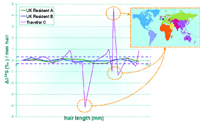What does your hair say about you?
14 Jul 2010 by Evoluted New Media
Did you know analysis of your hair can be used to track your geographical movements – In this the second on our series examining the science of forensics, Dr Rebeca Santamaria-Fernandez and Louise Dean tell us how
Did you know analysis of your hair can be used to track your geographical movements – In this the second on our series examining the science of forensics, Dr Rebeca Santamaria-Fernandez and Louise Dean tell us how
 Many of us know that hair can be used to determine if a person has taken drugs or alcohol, but few may know that the chemical composition of hair can provide interesting information about an individual’s geographical origin and other lifestyle factors. Scientists can find out where a person is from and even places they’ve visited by measuring the stable isotopic variations in human tissue – in particular hair – but it can be difficult to obtain high precision isotope ratios in samples of forensic interest.
Many of us know that hair can be used to determine if a person has taken drugs or alcohol, but few may know that the chemical composition of hair can provide interesting information about an individual’s geographical origin and other lifestyle factors. Scientists can find out where a person is from and even places they’ve visited by measuring the stable isotopic variations in human tissue – in particular hair – but it can be difficult to obtain high precision isotope ratios in samples of forensic interest.
LGC, the UK’s designated National Measurement Institute for chemical and bio-analytical measurement, in collaboration with the University of Oviedo, Spain, has developed a new mass spectrometry technique for the measurement of high precision isotope ratios in samples such as human (scalp) hair and tissue samples.
Keratin, a structural protein, is the main constituent of human hair. Keratin contains large amounts of the sulphur-containing amino acid cysteine; the disulphide bridges between amino acids give hair its strength. Throughout life, human hair and fingernails accumulate trace elements due to our bodies’ exposure to its environment, diet and lifestyle. Each of these trace elements has an isotopic profile which is unique to its source of origin. Therefore, the proportion of different isotopes present in a hair sample can provide information about the geographical movements of an individual. Hair is an attractive sample for forensic analysis due to its ease of collection, transport and handling. It can also be collected non-invasively, unlike DNA. However, in order to detect the extremely small variations in isotope ratios, a highly sensitive scientific method is required.
Stable isotope ratios of light elements such as carbon (13C/12C) and sulphur (34S/32S) are conventionally measured by gas source isotope ratio mass spectrometry (GS-IRMS). This technique is commonly used to solve food authenticity disputes such as farmed salmon being declared as wild salmon. However, limitations with this technique make it unsuitable for the very precise measurements required for the forensic analysis of hair samples. A new method is therefore being developed which involves the coupling of a laser ablation (LA) system to a multicollector inductively coupled plasma mass spectrometer (MC-ICP-MS). The MC-ICP-MS offers a lower level of uncertainty when compared to IRMS and is therefore better suited to detecting subtle changes in isotope ratios. The advantage of the laser ablation system is that it allows for the detection of sulphur isotope ratio variations at various points within a single hair sample, so that a chronological record of isotopic variations up to the time of sample collection can be obtained. IRMS however, requires a relatively large sample (several hairs compared with a single strand for LA-MC-ICP-MS) which must be ground and combusted before isotope measurements can be made. Traditional IRMS techniques cannot therefore provide the spatially resolved information from individual hair strands, as offered by LA-MC-ICP-MS. However, in order to be able to use isotopic information from hair as forensic evidence, this new method must be validated, reference samples characterised and uncertainties evaluated.
Method parameters were carefully optimised to achieve high spatial resolution and relative instrumental precision below 0.05% for sulphur isotope ratio measurements. During analysis, the laser beam is traversed along the length of the hair strand, producing ablation craters of 12 µm wide. This high spatial resolution enables analysis of individual strands, in thicknesses ranging from 40 µm to 120 µm. The laser makes contact with the selected hair fraction, eliminating surface contamination. Sulphur, generated as an aerosol from the hair’s keratin is then ionised within the plasma of the MC-ICP-MS allowing measurement of the exact proportions of sulphur isotopes present along the length of the hair strand. To evaluate the method, a horse hair sample, previously characterised for carbon and nitrogen isotope ratios, was characterised for sulphur isotope ratios. Sulphur isotope ratios in single hair strands from several volunteers have also been analysed using LA-MC-ICP-MS and the potential to accurately resolve longitudinal variations in isotope ratios have been demonstrated. This means the new methodology allows for the direct analysis of a single hair strand, providing the potential for a new, high throughput forensic tool.
|
Figure 1: Results illustrate the ability of the method to measure longitudinal variations in human hair strands from different individuals and the potential correlation between geographical movements and variations in 34S/32S |
Proof of concept of the method was demonstrated by LGC using hair samples from two residents of the United Kingdom, while a third individual – dubbed "the traveller" – had spent the previous six months living in Croatia, Austria and Australia before returning to the United Kingdom. Human hair growth is estimated to be 0.5cm to 1.5cm per month; 4cm to 5cm of hair could then provide one to six months of information relating to the geographical movements of an individual. The results of the experiment revealed that the traveller's hair showed significant variations in the sulphur isotopes, while isotope variations in the hair strands of the two United Kingdom residents were minimal1. Figure 1 identifies clear peaks caused by variations in 34S/32S which could indicate the traveller’s movement. These results demonstrate the potential use of LA-MC-ICP-MS in measuring small variations in sulphur isotope ratios within a single hair strand.
The precision of the method has been assessed using human and horse hair. The horse hair sample, previously characterised for sulphur isotope ratios, is employed as an in-house reference standard for the measurement of isotopic variations in human hair strands. The work is now being extended to the measurement of sulphur, carbon and nitrogen isotope ratios in hair samples from more than 100 volunteers with different diets, ethnic backgrounds and life-styles.
Initial results from LGC’s proof of concept show longitudinal stable sulphur isotopic variations in hair could potentially be used to indicate an individual’s recent geographical movements or to identify human bodies during forensic examination. However, isotopic composition of human hair strands could be affected by several factors such as individual biological processes and diets. Therefore, if a significant correlation can be established between the samples from the 100 volunteers, the method may be used by forensic scientists to map geographical variations for a wider population, offering the potential ability to track the movements of individuals, including international crime suspects and crime victims.
References: |







